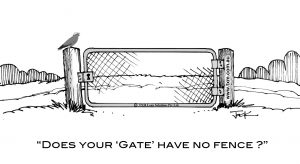
We have all read the books, we all know the theory – Lean business processes are GREAT! They cut waste, cut lead times and streamline processes. However the little secret that no one will tell you is that sometimes they just don’t work! In this blog we discuss a key reason why this happens.
When we develop Lean business processes it is common to establish “gates” or key points where we review progress of the process and make decisions. Whether it is customer service, product design, engineering projects, engineering customisation, or financial processing, decision gates are almost universal in office processes.
These decision gates might be to keep going with the process or to stop. They are a point to proceed or halt. Often the gates are cumbersome and eat into lead time.
The problem with business processes is that gates are often ignored. The check process they represent is not followed. The gates are still in place but a culture of going around the gate develops.
Gates are usually not visible. Unlike in a factory or warehouse, the “gate” is usually “virtual” rather than a physical barrier. Because the gate is not visual, it is therefore quite easy to work around it and keep going with the process, ignoring the various decision steps that are required. Often it seems quicker that way – until something goes wrong. Critical factors are overlooked, investment is made without a full consideration of the risks, costs and benefits or customer needs are ignored or misunderstood.
This is a bit like having a gate with no fence. The gate looks good, but is ineffective unless there is a fence to stop people going around it.
There are various ways to build a “fence”. Some software tools such as SAP have many such fences in the form of limits of authority and role separation. The danger is that these electronic “fences” often become a burden and merely a source of extra delay and bureaucracy. Hands up if you have ever authorised something on-line without fully understanding what you are authorising or if you have every failed to fully read a “health check” or “exception report” email. The reality is the volume of information generated by such electronic “fences” overwhelms most managers and “holes in the fence” soon appear in the form of workarounds or treating approvals as routine. Alternatively excessively rigid “fences” with too many approval and review steps can slow down decision making and cause non value added work, a bit like a rusty hinge makes a gate hard to open.
So how do you create an effective “fence” around your “gate” so that your lean business process can operate effectively and efficiency. One answer is to make the gate visual. Another answer is to reduce the number of gates and replace them with guidelines for passing.
There are lots of ways to create “visual gates” in Lean business processes. Red-Green tee cards (Kamisibai) can be very effective in ensuring that routine process steps and checks get completed in a timely fashion. Provided that there is an audit process to avoid “cheating” the red cards will clearly highlight steps that have not been completed, providing a visual “fence” that everyone in the office can see.
Daily stand up meetings can also facilitate effective “gates”. By queuing tasks and including routine “gate” reviews at each meeting, delays are minimised to a single day and the meeting provides a chance for everyone involved in the gate to acknowledge their approval at once (rather than having a form crawling around the office from in-box to in-box.
Another tool, a load levelling box (or Heijunka box) can ensure that tasks are completed in sequence and that backlogs and lead times are consistent and tightly controlled. They are designed to avoid tasks being pushed through the queue (“jumping the fence”) and to ensure all tasks pass through the gate in a reasonable time.
Reducing the number of gates is achieved by Value Stream Mapping. The mapping process defines the value of the process to the customer and then allows only tasks that are required to deliver the value.
The “fortified gate” would be in place to protect historic systems that no longer need the same level of control.
The “spotlight gate” shares good and often necessary work but the team can benefit from a very short acknowledgement and not the full theatrical play.
The “behind the times gate” is played out by the tollway gate. The manual toll booth has been replaced by electronic tags and customers are conditioned to expect not to stop to pay a toll.
The under maintained gate could be difficult to open with the rusty hinges, hastily fitted latch, or simply not hung with clearance to swing.
So next time you are designing a Lean business process and decide to include a “gate”, make sure that you also create a “fence” to avoid work- arounds. In offices we often look for costly IT solutions to control our processes. These are costly, can often over-complicate tasks and overload decision makers with information. This leads to “holes in the fence”. Lean business processes often rely on simple visual tools to facilitate communication and make sure that everyone “use’s the gate”.




